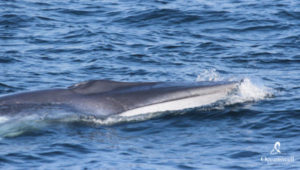Article by Andrew Howley of National Geographic Society on June 17, 2017
Photo Credits : Asha de Vos
While more than 125 National Geographic Explorers gathered at Society headquarters in Washington, D.C. this week for the 2017 Explorers Festival, hundreds more continued their Explorer activities in the field around the world.
Emerging Explorer Asha de Vos for one, has been busy publishing a paper announcing the first sighting of the little-known Omura’s whale in the waters of Sri Lanka.
Since these large baleen whales were only recognized as a distinct species in the past few decades, there is not much known about their lives, behavior, or distribution. So every new bit of info helps.
Over email from afar, Asha answered a few questions on the discovery and its significance.
What’s exciting about finding an Omura’s whale here?
Finding an Omura’s whale out in Sri Lankan waters is extremely significant and exciting because it’s a newly described species that we know very little about. It was originally identified as a distinct baleen whale species from Japan as recently as 2003.
This species is currently confirmed from the north-eastern and South Atlantic, western Pacific and Indian Ocean. The records from the Indian Ocean are largely from the ea stern Indian Ocean and more recently, with the discovery of a resident population of Omura’s whales in Madagascar, the southwestern Indian Ocean and one from Iran in the northwest Indian Ocean.
This species is now known from the northeastern and south Atlantic, western Pacific and Indian Ocean. If we look at the Indian Ocean, there have been records from the eastern Indian Ocean, the Western Indian Ocean (Madagascar)–which is a resident population, and one record from Iran which is in the Northwest Indian Ocean. Scientists originally believed that the eastern Indian ocean population was likely discontinuous from those in the western Indian Ocean but this record changes that. It is a missing piece of the jigsaw that provides some evidence of connectivity across the range.
Did anyone on the boat suspect at the time that this was an Omura’s whale? What clues finally convinced you that’s what you’d seen?
To be honest, when whales approach our boats we see so little of them particularly because most keep a low profile (unlike the more showy humpbacks) so its often difficult to register their characteristic features at a glance. However, The Sri Lankan Blue Whale Project and Oceanswell, my non-profit organization in Sri Lanka, maintains photo-identification catalogues for all whale species in our waters. Therefore, when we stopped our boat, I started to take photographs of this individual as I would any other baleen whale that came by. Lucky for me this whale was very relaxed and swam around the boat allowing me to take a bunch of photographs that I need for photo-identification purposes.
When we got back to shore and the team started sorting through the images we started to realise that this whale was different and it wasn’t the more commonly sighted Bryde’s whale. The lighter lower right jaw and chevron were key characteristics that made me question what I had seen because Bryde’s whales are essentially uniformly black. I promptly sent off a few of the images to a couple of my colleagues who are familiar with this species Dr. Robert Brownell and Dr. Salvatore Cerchio who were able to confirm that this was indeed an Omura’s whale.
What do we know about the behavior of these whales?
Most of what we know about this species is thanks to the work of Sal and his team in Madagascar. The population in Nosey Be is resident allowing researchers plenty of opportunity to collect good quality data on various aspects of this species. So far they have discovered that this species has a strange feeding behaviour where they filter out seemingly murky water.
The team suspects that the whales are filtering out fish eggs and tiny plankton that are invisible to the human eye. We also know a bit about their vocalizations thanks to extensive acoustic data collection and analysis by the team. But there’s so much left to learn.
I know you saw some injuries from fishing gear. Is there a chance local fishermen might actually know something about these whales?
For islanders Sri Lankans have very limited connection with the ocean, with most people not even being able to swim. The population of blue whales that I study under The Sri Lankan Blue Whale Project were largely unknown until 9 years ago when I started the first long-term study in the region. They have been around for centuries but given that the ocean is not a recreational space, they were very much overlooked. Fishermen likely saw these and many other species of whales but it is unlikely that they could distinguish this from the others.
Unfortunately entanglement is a problem for all whales as the oceans are filled with ghost fishing gear that drift around and wrap themselves on marine species. The fact that we found the scar on this individual confirms that it is an issue for Omura’s whales in Sri Lanka, just as it is a problem in Thailand.
What were your thoughts when you realized you had found one of these recently identified whales?
I was pretty darn ecstatic! I’ve always maintained that the northern Indian Ocean is the most diverse and exciting ocean basin to work in because it is probably the most understudied ocean basin. The vast majority of the countries within this area are considered “developing” and understandably priorities have never been to explore and unravel the mysteries of the oceans.
My desire to explore and unravel stems from the fact that I want to bring the magic of this big blue tank of water to everyone, so we can engage people, start to understand how its health is intrinsically linked to our own, and allow everyone to be part of the solution and not just part of the problem.
Findings like these are important on so many levels. Personally, who doesn’t want to be the discoverer of a new species! I was so ridiculously excited but had to keep everything under wraps until the publication came out–keeping such BIG secrets is never easy!
This finding is also important for Sri Lankans, because it adds another species to our list, reminds us that we have a lot to be proud about and shows that there is so much out there left to learn and protect. Finally, this finding is incredibly important at a global level because of how little we actually know of this species. Every little bit of information counts. The more we know, the better we can protect them.
What are the bigger implications for finding such a huge animal that no one had noticed before?
“To me, a finding of this nature is incredibly symbolic. Omura’s whales grow to 33 feet. They aren’t invisible to the eye and they are not easily overlooked. However, we know next to nothing about them and are still discovering where they roam. It’s different if this species lived in the deep sea but all evidence from Sri Lanka and Madagascar point to the fact that this species prefers shallow shelf waters–areas that are constantly being accessed by people. So if we are overlooking these giants, imagine what else we are missing out on? Imagine what else there is yet to learn? Imagine the abundance of life that is waiting to be discovered and then … protected?
Article extracted from : http://voices.nationalgeographic.com


